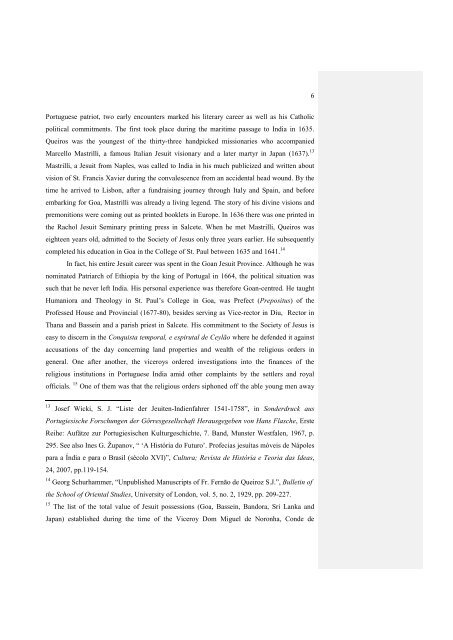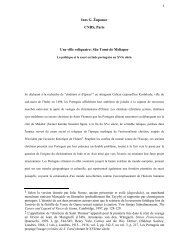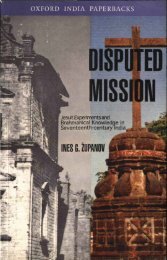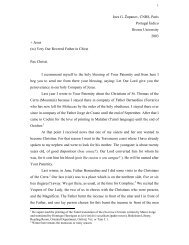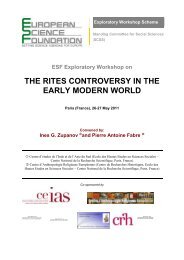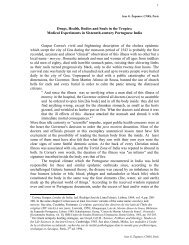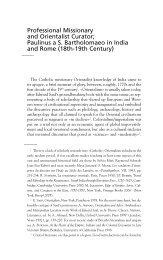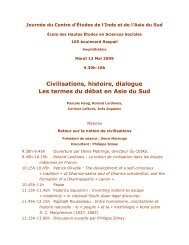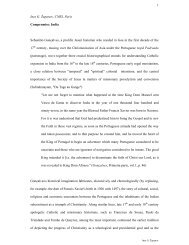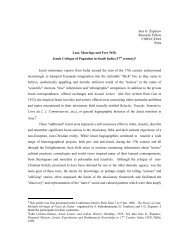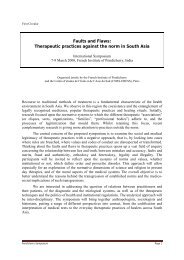Jesuit Orientalism; - Ines G. Županov
Jesuit Orientalism; - Ines G. Županov
Jesuit Orientalism; - Ines G. Županov
You also want an ePaper? Increase the reach of your titles
YUMPU automatically turns print PDFs into web optimized ePapers that Google loves.
6<br />
Portuguese patriot, two early encounters marked his literary career as well as his Catholic<br />
political commitments. The first took place during the maritime passage to India in 1635.<br />
Queiros was the youngest of the thirty-three handpicked missionaries who accompanied<br />
Marcello Mastrilli, a famous Italian <strong>Jesuit</strong> visionary and a later martyr in Japan (1637). 13<br />
Mastrilli, a <strong>Jesuit</strong> from Naples, was called to India in his much publicized and written about<br />
vision of St. Francis Xavier during the convalescence from an accidental head wound. By the<br />
time he arrived to Lisbon, after a fundraising journey through Italy and Spain, and before<br />
embarking for Goa, Mastrilli was already a living legend. The story of his divine visions and<br />
premonitions were coming out as printed booklets in Europe. In 1636 there was one printed in<br />
the Rachol <strong>Jesuit</strong> Seminary printing press in Salcete. When he met Mastrilli, Queiros was<br />
eighteen years old, admitted to the Society of Jesus only three years earlier. He subsequently<br />
completed his education in Goa in the College of St. Paul between 1635 and 1641. 14<br />
In fact, his entire <strong>Jesuit</strong> career was spent in the Goan <strong>Jesuit</strong> Province. Although he was<br />
nominated Patriarch of Ethiopia by the king of Portugal in 1664, the political situation was<br />
such that he never left India. His personal experience was therefore Goan-centred. He taught<br />
Humaniora and Theology in St. Paul‟s College in Goa, was Prefect (Prepositus) of the<br />
Professed House and Provincial (1677-80), besides serving as Vice-rector in Diu, Rector in<br />
Thana and Bassein and a parish priest in Salcete. His commitment to the Society of Jesus is<br />
easy to discern in the Conquista temporal, e espirutal de Ceylão where he defended it against<br />
accusations of the day concerning land properties and wealth of the religious orders in<br />
general. One after another, the viceroys ordered investigations into the finances of the<br />
religious institutions in Portuguese India amid other complaints by the settlers and royal<br />
officials. 15 One of them was that the religious orders siphoned off the able young men away<br />
13 Josef Wicki, S. J. “Liste der Jeuiten-Indienfahrer 1541-1758”, in Sonderdruck aus<br />
Portugiesische Forschungen der Görresgesellschaft Herausgegeben von Hans Flasche, Erste<br />
Reihe: Aufätze zur Portugiesischen Kulturgeschichte, 7. Band, Munster Westfalen, 1967, p.<br />
295. See also <strong>Ines</strong> G. <strong>Županov</strong>, “ „A História do Futuro‟. Profecias jesuítas móveis de Nápoles<br />
para a Índia e para o Brasil (sécolo XVI)”, Cultura; Revista de História e Teoria das Ideas,<br />
24, 2007, pp.119-154.<br />
14 Georg Schurhammer, “Unpublished Manuscripts of Fr. Fernão de Queiroz S.J.”, Bulletin of<br />
the School of Oriental Studies, University of London, vol. 5, no. 2, 1929, pp. 209-227.<br />
15 The list of the total value of <strong>Jesuit</strong> possessions (Goa, Bassein, Bandora, Sri Lanka and<br />
Japan) established during the time of the Viceroy Dom Miguel de Noronha, Conde de


